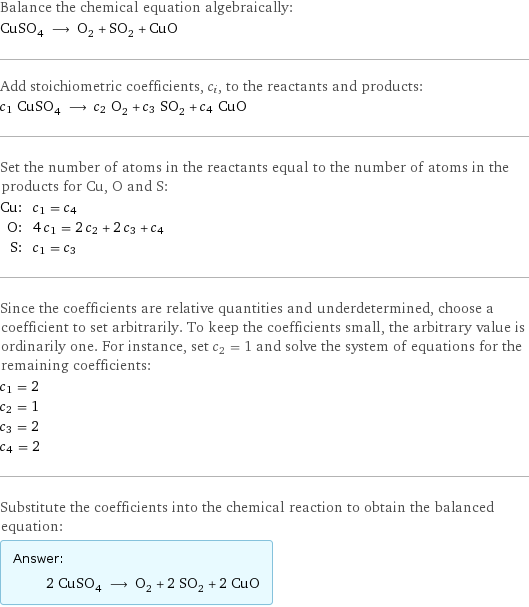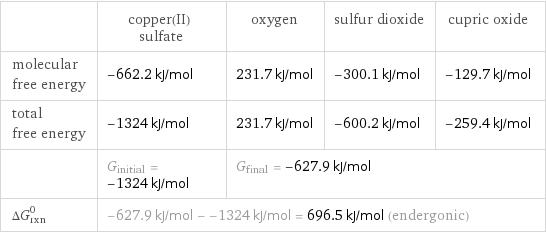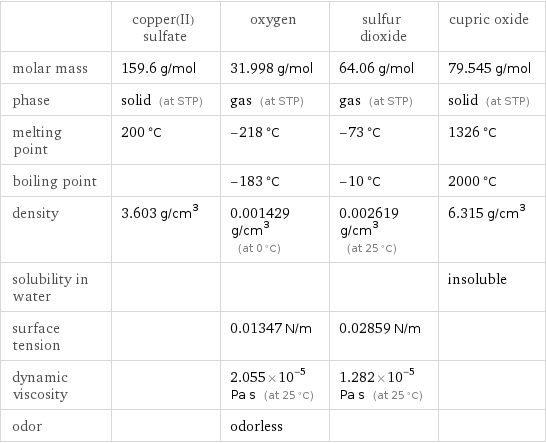Input interpretation

CuSO_4 copper(II) sulfate ⟶ O_2 oxygen + SO_2 sulfur dioxide + CuO cupric oxide
Balanced equation

Balance the chemical equation algebraically: CuSO_4 ⟶ O_2 + SO_2 + CuO Add stoichiometric coefficients, c_i, to the reactants and products: c_1 CuSO_4 ⟶ c_2 O_2 + c_3 SO_2 + c_4 CuO Set the number of atoms in the reactants equal to the number of atoms in the products for Cu, O and S: Cu: | c_1 = c_4 O: | 4 c_1 = 2 c_2 + 2 c_3 + c_4 S: | c_1 = c_3 Since the coefficients are relative quantities and underdetermined, choose a coefficient to set arbitrarily. To keep the coefficients small, the arbitrary value is ordinarily one. For instance, set c_2 = 1 and solve the system of equations for the remaining coefficients: c_1 = 2 c_2 = 1 c_3 = 2 c_4 = 2 Substitute the coefficients into the chemical reaction to obtain the balanced equation: Answer: | | 2 CuSO_4 ⟶ O_2 + 2 SO_2 + 2 CuO
Structures

⟶ + +
Names

copper(II) sulfate ⟶ oxygen + sulfur dioxide + cupric oxide
Reaction thermodynamics
Enthalpy

| copper(II) sulfate | oxygen | sulfur dioxide | cupric oxide molecular enthalpy | -771.4 kJ/mol | 0 kJ/mol | -296.8 kJ/mol | -157.3 kJ/mol total enthalpy | -1543 kJ/mol | 0 kJ/mol | -593.6 kJ/mol | -314.6 kJ/mol | H_initial = -1543 kJ/mol | H_final = -908.2 kJ/mol | | ΔH_rxn^0 | -908.2 kJ/mol - -1543 kJ/mol = 634.6 kJ/mol (endothermic) | | |
Gibbs free energy

| copper(II) sulfate | oxygen | sulfur dioxide | cupric oxide molecular free energy | -662.2 kJ/mol | 231.7 kJ/mol | -300.1 kJ/mol | -129.7 kJ/mol total free energy | -1324 kJ/mol | 231.7 kJ/mol | -600.2 kJ/mol | -259.4 kJ/mol | G_initial = -1324 kJ/mol | G_final = -627.9 kJ/mol | | ΔG_rxn^0 | -627.9 kJ/mol - -1324 kJ/mol = 696.5 kJ/mol (endergonic) | | |
Equilibrium constant
![Construct the equilibrium constant, K, expression for: CuSO_4 ⟶ O_2 + SO_2 + CuO Plan: • Balance the chemical equation. • Determine the stoichiometric numbers. • Assemble the activity expression for each chemical species. • Use the activity expressions to build the equilibrium constant expression. Write the balanced chemical equation: 2 CuSO_4 ⟶ O_2 + 2 SO_2 + 2 CuO Assign stoichiometric numbers, ν_i, using the stoichiometric coefficients, c_i, from the balanced chemical equation in the following manner: ν_i = -c_i for reactants and ν_i = c_i for products: chemical species | c_i | ν_i CuSO_4 | 2 | -2 O_2 | 1 | 1 SO_2 | 2 | 2 CuO | 2 | 2 Assemble the activity expressions accounting for the state of matter and ν_i: chemical species | c_i | ν_i | activity expression CuSO_4 | 2 | -2 | ([CuSO4])^(-2) O_2 | 1 | 1 | [O2] SO_2 | 2 | 2 | ([SO2])^2 CuO | 2 | 2 | ([CuO])^2 The equilibrium constant symbol in the concentration basis is: K_c Mulitply the activity expressions to arrive at the K_c expression: Answer: | | K_c = ([CuSO4])^(-2) [O2] ([SO2])^2 ([CuO])^2 = ([O2] ([SO2])^2 ([CuO])^2)/([CuSO4])^2](../image_source/16d69321b7114a379ab2f5c854162993.png)
Construct the equilibrium constant, K, expression for: CuSO_4 ⟶ O_2 + SO_2 + CuO Plan: • Balance the chemical equation. • Determine the stoichiometric numbers. • Assemble the activity expression for each chemical species. • Use the activity expressions to build the equilibrium constant expression. Write the balanced chemical equation: 2 CuSO_4 ⟶ O_2 + 2 SO_2 + 2 CuO Assign stoichiometric numbers, ν_i, using the stoichiometric coefficients, c_i, from the balanced chemical equation in the following manner: ν_i = -c_i for reactants and ν_i = c_i for products: chemical species | c_i | ν_i CuSO_4 | 2 | -2 O_2 | 1 | 1 SO_2 | 2 | 2 CuO | 2 | 2 Assemble the activity expressions accounting for the state of matter and ν_i: chemical species | c_i | ν_i | activity expression CuSO_4 | 2 | -2 | ([CuSO4])^(-2) O_2 | 1 | 1 | [O2] SO_2 | 2 | 2 | ([SO2])^2 CuO | 2 | 2 | ([CuO])^2 The equilibrium constant symbol in the concentration basis is: K_c Mulitply the activity expressions to arrive at the K_c expression: Answer: | | K_c = ([CuSO4])^(-2) [O2] ([SO2])^2 ([CuO])^2 = ([O2] ([SO2])^2 ([CuO])^2)/([CuSO4])^2
Rate of reaction
![Construct the rate of reaction expression for: CuSO_4 ⟶ O_2 + SO_2 + CuO Plan: • Balance the chemical equation. • Determine the stoichiometric numbers. • Assemble the rate term for each chemical species. • Write the rate of reaction expression. Write the balanced chemical equation: 2 CuSO_4 ⟶ O_2 + 2 SO_2 + 2 CuO Assign stoichiometric numbers, ν_i, using the stoichiometric coefficients, c_i, from the balanced chemical equation in the following manner: ν_i = -c_i for reactants and ν_i = c_i for products: chemical species | c_i | ν_i CuSO_4 | 2 | -2 O_2 | 1 | 1 SO_2 | 2 | 2 CuO | 2 | 2 The rate term for each chemical species, B_i, is 1/ν_i(Δ[B_i])/(Δt) where [B_i] is the amount concentration and t is time: chemical species | c_i | ν_i | rate term CuSO_4 | 2 | -2 | -1/2 (Δ[CuSO4])/(Δt) O_2 | 1 | 1 | (Δ[O2])/(Δt) SO_2 | 2 | 2 | 1/2 (Δ[SO2])/(Δt) CuO | 2 | 2 | 1/2 (Δ[CuO])/(Δt) (for infinitesimal rate of change, replace Δ with d) Set the rate terms equal to each other to arrive at the rate expression: Answer: | | rate = -1/2 (Δ[CuSO4])/(Δt) = (Δ[O2])/(Δt) = 1/2 (Δ[SO2])/(Δt) = 1/2 (Δ[CuO])/(Δt) (assuming constant volume and no accumulation of intermediates or side products)](../image_source/e0614438e45f4174f580bddcd6f39f8e.png)
Construct the rate of reaction expression for: CuSO_4 ⟶ O_2 + SO_2 + CuO Plan: • Balance the chemical equation. • Determine the stoichiometric numbers. • Assemble the rate term for each chemical species. • Write the rate of reaction expression. Write the balanced chemical equation: 2 CuSO_4 ⟶ O_2 + 2 SO_2 + 2 CuO Assign stoichiometric numbers, ν_i, using the stoichiometric coefficients, c_i, from the balanced chemical equation in the following manner: ν_i = -c_i for reactants and ν_i = c_i for products: chemical species | c_i | ν_i CuSO_4 | 2 | -2 O_2 | 1 | 1 SO_2 | 2 | 2 CuO | 2 | 2 The rate term for each chemical species, B_i, is 1/ν_i(Δ[B_i])/(Δt) where [B_i] is the amount concentration and t is time: chemical species | c_i | ν_i | rate term CuSO_4 | 2 | -2 | -1/2 (Δ[CuSO4])/(Δt) O_2 | 1 | 1 | (Δ[O2])/(Δt) SO_2 | 2 | 2 | 1/2 (Δ[SO2])/(Δt) CuO | 2 | 2 | 1/2 (Δ[CuO])/(Δt) (for infinitesimal rate of change, replace Δ with d) Set the rate terms equal to each other to arrive at the rate expression: Answer: | | rate = -1/2 (Δ[CuSO4])/(Δt) = (Δ[O2])/(Δt) = 1/2 (Δ[SO2])/(Δt) = 1/2 (Δ[CuO])/(Δt) (assuming constant volume and no accumulation of intermediates or side products)
Chemical names and formulas

| copper(II) sulfate | oxygen | sulfur dioxide | cupric oxide formula | CuSO_4 | O_2 | SO_2 | CuO Hill formula | CuO_4S | O_2 | O_2S | CuO name | copper(II) sulfate | oxygen | sulfur dioxide | cupric oxide IUPAC name | copper sulfate | molecular oxygen | sulfur dioxide |
Substance properties

| copper(II) sulfate | oxygen | sulfur dioxide | cupric oxide molar mass | 159.6 g/mol | 31.998 g/mol | 64.06 g/mol | 79.545 g/mol phase | solid (at STP) | gas (at STP) | gas (at STP) | solid (at STP) melting point | 200 °C | -218 °C | -73 °C | 1326 °C boiling point | | -183 °C | -10 °C | 2000 °C density | 3.603 g/cm^3 | 0.001429 g/cm^3 (at 0 °C) | 0.002619 g/cm^3 (at 25 °C) | 6.315 g/cm^3 solubility in water | | | | insoluble surface tension | | 0.01347 N/m | 0.02859 N/m | dynamic viscosity | | 2.055×10^-5 Pa s (at 25 °C) | 1.282×10^-5 Pa s (at 25 °C) | odor | | odorless | |
Units
